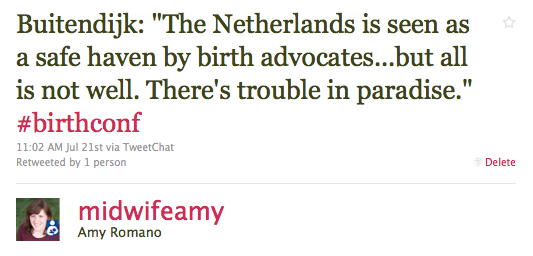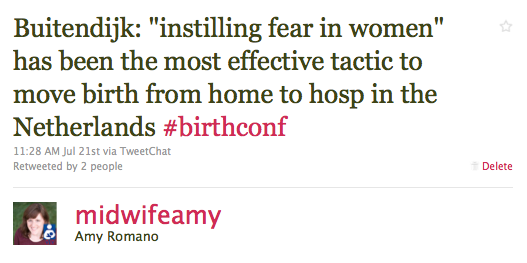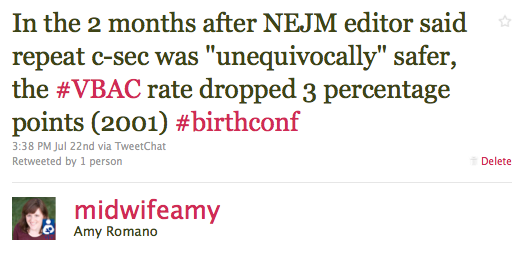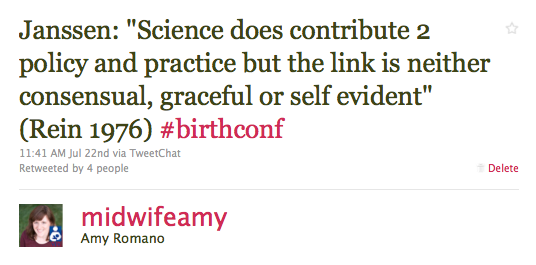Shake it up: Why we need research and activism to change maternity care
By: Amy M. Romano, RN,CNM | 0 Comments
Last week, I attended the Normal Labour & Birth International Research Conference in Vancouver, British Columbia. With over 250 attendees from 23 countries, the conference set out to disseminate research about the nature of and optimal care for physiologic labor and birth, and to garner multidisciplinary perspectives on the implications for clinical practice, perinatal outcomes, education, management, collaboration, and policy.
I went as an agent of data dissemination. My job: to use social media (blogs, Twitter) to help make sure the conference proceedings didn't just rattle around the four walls of the conference hotel, but got out to those in the field working to improve maternity care wherever we each are.
And I have some research I want to write about - really interesting, important research from every discipline you could imagine. But I left the three-day meeting thinking more about the (broken) link between evidence and practice than about any of the new, emerging evidence. I'll get to the new research over the coming weeks, but first, a look at two stories that dominated the conference.
#1: Home birth on the defensive?
The plenary session by Dutch physician and epidemiologist, Simone Buitendijk, might have highlighted the unique model of midwife-led primary care geared toward planned home birth for low-risk women - a model that many birth advocates and researchers look to as a beacon of hope and reason. Buitendijk herself was co-author of the definitive study of planned home birth safety, a population-based study of over half a million births that found planned midwife-attended home birth as safe as planned midwife-attended hospital birth. And a Cochrane systematic review that came out around the same time as the Dutch home birth study provideddefinitive evidence that midwife-led care is superior to physician-led or shared models of care. So the Dutch have gotten it right, right? Time to celebrate and emulate? No, instead of a plenary about Dutch primary maternity care as a model to emulate, Buitendijk's talk was a sobering call to action.

According to Buitendijk, in spite of this evidence (or perhaps in direct response to this evidence?) a well-coordinated media campaign in the Netherlands over the past year has emphasized the dangers of home birth, pointing to an entirely different body of evidence: comparative data showing that Dutch perinatal mortality rates are higher than those in other European countries. Although only about 30 of the 1700 Dutch perinatal deaths occurred at home, and perinatal mortality at the population level is affected far more by incidence and management of preterm birth and congenital anomalies than by the labor and birth care of low-risk women with term pregnancies, the Dutch mass media have made this a story about midwifery care and home birth. The result: the rate of home birth has dipped below 25% for the first time in Dutch history.

#2 VBAC is Back?
Eugene Declercq, who gives - hands down - the world's most engaging and fun lectures about perinatal statistics, had the pleasure of making an 11th hour revision to his plenary talk on vaginal birth after cesarean (VBAC) thanks to ACOG, who released their new VBAC practice guidelines at 5pm the day prior. (Hat tip to yours truly for tipping him off about the new guidelines. I even got written into his plenary remarks, as the young woman with whom he had a 'stimulating conversation' that led him to 'stay up all night.' Har har, Gene!)
Anyway, we see in Declercq's talk the familiar story of how VBAC rates increased briefly then plummeted in the early 2000's as a result of new research on uterine rupture and, more precisely, an editorial by the ob-gyn editor for the New England Journal of Medicine saying that planned repeat cesarean is 'unequivocally' safer than planned VBAC.

Research driving practice! That is, if the research (or overzealous interpretations of it) supports restricting practice.
Where's the up-tick in VBAC rates when the Cochrane systematic review was published in 2004 concluding that 'Planned elective repeat caesarean section and planned vaginal birth after caesarean section for women with a prior caesarean birth are both associated with benefits and harms?' The up-tick isn't there because by then research wasn't driving practice - ACOG guidelines calling for 'immediately available' emergency obstetric care in VBAC labors were driving practice. And it wasn't the NIH Consensus Development Conference on VBAC or the massive AHRQ systematic review underpinning the conference (i.e., evidence) that have been heralded as the beginning of the end of hospital 'VBAC bans,' it's ACOG's (somewhat noncommittal) move away from the 'immediately available' standard.
Evidence is not driving practice. Between evidence and practice there lives some kind of cocktail of power, money, activism, media, influence and serendipity (and preservatives). The relative strength of the ingredients dictates how practices evolve. Keeping with the cocktail metaphor, the VBAC plenary ended with an invitation to consumers and our advocates to shake things up - activism being the best hope for ACOG's new guidelines to be used to drive meaningful change for the many, many childbearing women in the United States with scarred uteruses.
This all reminds me of a third plenary talk at the Normal Birth Conference - Patti Janssen's lecture, Transforming Research into Policy: Ingredients of Influence, in which she quotes social scientist, Martin Rein.

It also reminds me of Kay Dickerson of the Cochrane Collaboration who said, 'We are only to get evidence-based healthcare in this country through consumer activism.'
More on Janssen's plenary, and updates on the research, coming soon.
Published: July 25, 2010
Tags
VBACACOGHome BirthProfessional ResourcesMaternity Care SystemsNIH Consensus ConferenceBirth Conference